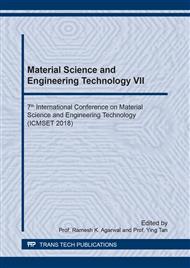p.110
p.117
p.123
p.128
p.133
p.138
p.144
p.149
p.154
The Features of a High-Temperature Synthesis of ZrO2 in a Core-Shell ZrO2@C Structure
Abstract:
Zirconium oxide was obtained via traditional precipitation from a ZrOCl2 solution with ammonia followed by drying at 110 °C. The carbon-coated samples were synthesized by calcination of the pristine zirconia mixed with polyvinylalcohol. The obtained ZrO2@C samples of core-shell structure as well as the reference samples of pristine zirconia were calcined at different temperatures from 500 to 1400 °C. All the materials were examined by a set of physicochemical methods (a low-temperature argon adsorption, transmission electron microscopy, X-ray diffraction analysis, photoluminescence spectroscopy). It was found that the carbon coating prevents the sintering of the oxide nanoparticles, which allows one to maintain the specific surface area, the size of the oxide core and, finally, stabilize its phase composition. Transformation of the cubic phase into monoclinic phase becomes significantly complicated. Thus, 40% of the cubic phase was detected even after calcination of the ZrO2@C sample at 1400 °C. Moreover, the carbon-coated samples treated at elevated temperatures with subsequent removal of the carbon shell were found to possess the highest concentration of the defects related to a presence of the anion vacancies in zirconia.
Info:
Periodical:
Pages:
133-137
Citation:
Online since:
April 2019
Price:
Сopyright:
© 2019 Trans Tech Publications Ltd. All Rights Reserved
Share:
Citation:


